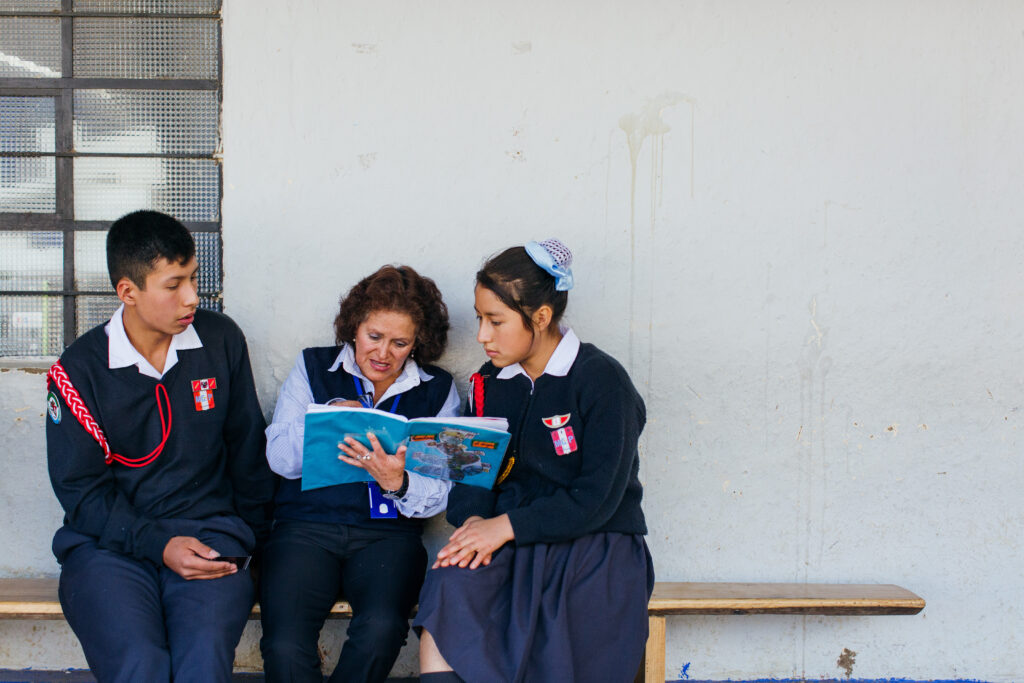by Nora Lissette Herrera Illescas, Institutional Strengthening Officer, Water For People Guatemala
This blog was the winner of our first Water For People blog competition among all of our colleagues around the globe. Congratulations Nora!
Versión en español aquí.
Forests, Communities, and Authorities: Connections for Life
The Quiché mountains of Guatemala evoke memories of the pleasant sound of water running through their lands. The whisper of feet that go deep into the forest to conquer a water source. The wounds caused by the trenches dug by the arms of thousands of people who lay pipes to bring water to their communities. The water sources and creeks watch over the joyful chatter of women who confide their secrets about long days of invisible work at home. The mountain dwellers whisper that peace has returned and the rain is beckoned by the guardabarranco, the mockingbird, and other birds with their happy songs, as told by one of the myths.

Water for human consumption is a collective effort that enables encounters between mountains, human beings, institutions, and donors. Alliances allow tangible results in Quiché, and 118 communities testify how the collective effort enables the achievement of a better quality of life. Access to water transforms dreams into reality. "After digging ditches on the mountain and laying pipes for a month, we continued the work to where the catchment tank is located. We achieved 21 kilometers, thanks to community unity," explained Calixto García, president of the organization from Llano Grande, a community located in San Andrés Sajcabajá.
Reaching each home was another goal. For four months, we watched as the ditches formed paths of hope that connected each house to the distribution system. "When the water test was conducted, the sky was filled with joy. Each family launched a pop-rocket confirming that the water had reached their home," says Maricela Castro, a citizen from Llano Grande. Another dream was to declare themselves free of contamination. It was another titanic task for everyone in Llano Grande, as each family had to fulfill the agreement to implement a sanitation technology for the disposal of excreta. According to the records of the Community Development Council (COCODE, for the Spanish acronym), "Just one person is left to do their bathroom here in Llano Grande." Extending the benefit to all communities in the municipalities of Santa Cruz del Quiché, San Bartolomé Jocotenango, San Andrés Sajcabajá, and San Antonio Ilotenango is a commitment that guides the work of Water For People in Guatemala: reaching each home, community, school, and health clinic with access to water, sanitation, and hygiene.
Working with sustainability principles

Grandmothers and grandfathers (the venerable members of the community in the Maya-Quiché culture) teach that water is sacred. In the Maya Worldview, the world is represented by two colors: green for vegetation and Mother Earth, and blue for the bodies of water and sky. Together they represent our common home: the Earth. Ancestral knowledge promotes principles that teach that all living beings and nature are related in a spiral where each living being is a complement. When complementarity is broken, equilibrium is broken.
Cultural syncretism modified the relationships between human beings and nature. Water For People understands that ways of life and community values are sacred, and to better understand them, their teams come from K’iche’ speaking communities. Water encourages municipalities and communities to meet in order to establish a great agreement, through consensus so that water services are Forever.
The community structure is strengthened with new and committed leaders. Trust is placed in plumbers and water committees "so that there is no shortage of water," explained Rosita, one of the women who has stopped carrying water and walking two hours to an unsafe water source. Given the specialized education for the maintenance of water networks, Water For People implemented alternative schools for water and sanitation. They are capacity building processes on administration, operation, and maintenance in water and sanitation that the municipalities replicate. These spaces have graduated 236 plumbers and 15 water technicians to manage, operate, and maintain services. The municipalities are strengthened to fulfill their responsibilities for water and sanitation with plans, personnel, financing, and methodologies, among other aspects. To date, 236 water organizations operate in the municipalities where Water For People works. Municipal Water and Sanitation Offices (OMAS) provide support along with Water For People staff, until they declare Everyone Forever Milestones have been reached.
Returning to nature ensures water today and Forever
The squirrel asked the guardabarranco, "Do you hear the footsteps of humans?" They both fell silent to hear where they were coming from. The guardabarranco flew over the group. He went closer to listen carefully to the conversation. Juan (president of the community) indicated that the area to be reforested was marked in advance. The OMAS and forestry technicians also gave instructions on the correct way to plant trees. The first was planted by the manager of the municipal nursery, followed by others. A total of 73.34 hectares of forest was under management by 2019, as the table below summarizes.


The festival of the forest dwellers began when the group left. Squirrels, skunks, raccoons, goats, foxes, and birds chatted and called for rain to ensure that the new forest dwellers would stay forever. After a year, the inspector from the National Forest Institute (INAB) arrived to verify that the saplings were alive and to grant a forestry incentive. The Santa Cruz del Quiché and San Bartolomé Jocotenango municipalities, through their technical offices, successfully initiated Integrated Water Resources Management (IWRM) activities in strategic areas. In San Antonio Ilotenango, strategic water sources and recharge areas are located in a different municipality, and water users coordinated with them to reforest and prevent fires. This year, San Andrés Sajcabajá has hired a forestry technician and is preparing to promote mitigation and conservation actions.
Water comes from the mountain and humans return it to maintain the cycle of life!



